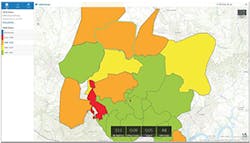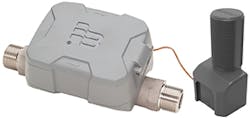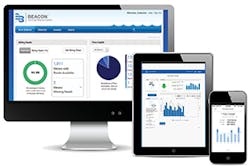Exploring New Ways to Use Data From AMI Systems
It wasn’t long ago that automated meter reading (AMR) and advanced metering infrastructure (AMI) were a pair of luxuries that most water utilities couldn’t afford.
Those days are over. Water experts say that both AMR and AMI are tech that utilities absolutely need if they are to reduce the amount of non-revenue water they lose each year and provide their customers with a detailed analysis of their daily water consumption.
What’s most interesting, though, is that while more utilities are investing in AMI and AMR, many others are also exploring new ways to use the data that come from AMI systems.
These utilities are not just using AMI to more accurately bill their customers. They’re using the technology to streamline their operations and deliver water more efficiently throughout their systems.
And it’s a trend that isn’t about to slow. John Fillinger, utility marketing manager with Milwaukee-based Badger Meter, says that the trend toward AMI is so strong that a growing number of utilities are jumping directly from manual meter reading to fixed-network technology, bypassing the traditional second step of moving first to AMR before they invest in more robust AMI systems.
Why are utilities making this leap? Fillinger says that utilities can now see plenty of examples in which a fixed-network AMI system has helped other municipal water departments save significant money. These real-life examples make the prospect of upgrading to this tech less intimidating.
“We have more utilities that are deploying fixed-network technology,” says Fillinger. “Once you have a city that deploys this technology, the surrounding communities take notice and see the benefits. They are able to visit that utility and see how it works, rather than having to put in a pilot program themselves. They can learn from the experience of others. The technology has evolved. It’s not as frightening or complex as utilities once thought.”
A BUSINESS DECISION
Fillinger says that there are important business reasons for utilities to embrace AMI technology. And because they are so compelling, it’s little surprise that AMI technology is steadily becoming a more common investment on the part of utilities.
“How can utilities do more with less? Everyone’s budgets are a little bit tighter,” says Fillinger. “Our water customers want to know how they can use technology to do what they have to do while still being able to provide additional value to their end-users. That is what they are struggling with, and that is what AMI can help with.”
Customer service matters, too. Fillinger says that utilities, once they have access to the impressive amount of data that AMI systems can deliver, can pass this information on to their customers. These end-users can then better understand why their bills might be higher one month and lower the next when they mistakenly believe that they haven’t changed their consumption habits.
AMI helps utilities spot possible leaks faster, too, simply by showing unexpected spikes in consumption at certain hours of the day among end-users.
“Non-revenue water, water lost through leaks, is another focus for utilities,” says Fillinger. “How can utilities get their arms around how serious their water-loss problems might be if they are only getting meter readings once a month? If they are truly interested in bringing that number down, the more information they can get, the better off they will be. That can help drive changes. AMI can help bring that non-revenue water number down.”
Warren Ault, NA product manager for AMI and software with Kamstrup Water Metering, says that technology today is allowing water utilities to catch the smallest of leaks. And that is one reason why so many more utilities are at least exploring the benefits of AMI technology today, he says.
“The information that this technology provides is so important for utilities,” says Ault. “Utilities can be more proactive when it comes to leak detection and alerting customers of possible leaks. The adoption rates of AMI aren’t quite as high as we’d like them to be. But the tools are there now. It is easy to make the case why utilities should embrace this technology.”
A depiction of the many capabilities of Neptune’s software systems
EASIER TO USE, THANKS TO SAAS
Dan Pinney, senior director of global water marketing with Sensus, a Xylem brand, says that more utilities will embrace AMI technology as these systems become ever easier to use and maintain. Fortunately, that is happening now.
A big reason? The rise of software as a service, also known as SaaS.
In the SaaS model, third-party providers—such as the makers of AMI systems—host applications on their own servers. They then make these applications available to their customers through the Internet. Customers simply log onto a web-based portal, enter their login information, and access the application.
The benefit of this is that those customers don’t have to worry about hosting this technology on their own. And they don’t have to worry about managing the back-end workings of the systems.
In the case of AMI, this makes accessing the valuable data that this technology provides easier for utilities that don’t want to bother with installing programs on their own computers.
“There is a lot of value for utilities in the software as a service approach,” says Pinney. “The utility doesn’t have to manage the network or back end. That’s important because so many utilities are already stretched thin. This gives them access to so much data about their water systems without having to host anything.”
As AMI systems get less complicated, utility managers are also learning just how powerful they can be. Those utilities that analyze the data these systems provide can deliver water in a far more efficient manner to their customers, saving a significant amount of money as they do so.
Pinney says that utilities armed with data provided by AMI technology can, for instance, pinpoint leaks or pipe breaks far earlier than those without this technology. They can then fix these problems before they grow into more serious, and expensive, issues. Utilities, for instance, can fix a leaking pipe before that pipe bursts or repair a water main before it collapses a section of roadway.
“Because of everything this technology can do, I don’t really like the term ‘advanced metering infrastructure,’” says Pinney. “This technology goes far beyond just metering.”
For Pinney, this technology is about creating what he calls a “smart utility.” It’s a way for utility personnel to use information that they gather anyway to deliver water more efficiently. Utilities without AMI tech gather most of their data manually. That makes it harder for them to see important connections.
Pinnney points to a utility in Hendersonville, NC, as a good example of how AMI can make a difference. Sensus not only deployed an AMI system with meters providing readings every hour, but the company also deployed pressure sensors at strategic locations around the utility’s distribution zone.
Evides is one of the largest water utilities in the Netherlands. The screen shows a computer simulation of a leak in progress. By tapping into the data in real-time and setting up alerts, the utility can more quickly pinpoint new leaks, send out service crews, and start repairs.
This means that utility officials here can discover broken pipes within minutes of them actually breaking. The secret is to combine flow data with pressure data. The AMI tech can tell the utility, for instance, that a break occurred at 3 a.m. Utility personnel can then find within 100 yards where the actual break is by analyzing pressure-drop information provided by sensors. The largest pressure drops will be at the point where the pipe break occurred.
“They don’t have to go out and hunt for that break,” says Pinney. “The system tells them exactly where to go.”
AMI technology, then, doesn’t just save utilities money—though it does do that—it also helps municipalities avoid costly disruptions.
This exact scenario played out in Hendersonville. Officials used AMI data to discover a leak from a water main that was under a street. If officials didn’t address it in time because they were unable to find it, the break could have caused serious damage.
Not only would the municipality have had to pay for costly repairs, both to the water main and possibly to the street above it, but officials would also have had to deal with the bad publicity that a serious water main break can cause.
This image shows a screenshot of how White House Utility District looks for leaks. WHUD essentially monitors water inflow with 79 new smart meters and outflow through its SCADA system. By combining both sources of data into the PI System, they can detect if there are unusual surges of consumption, a possible sign of leakage.
But with that combination of flow and pressure information, utility officials resolved the problem before a bigger issue arose.
“They were able to pinpoint that and fix it quickly,” says Pinney. “It also saved the community a tremendous amount of disruption.”
BETTER DATA
Hendersonville, of course, is far from the only utility that is benefitting from the mountains of data that AMI systems can generate. Ault says that a growing number of utilities today rely heavily on this quality data to better serve their customers.
“Good data on a predictable and timely basis is what this technology can offer,” says Ault. “The better the data, the less challenging it is for utilities to find leaks, the less likely they are to suffer as much non-revenue water loss. The more frequent reads utilities get from their meters, the more likely they are to have the data they need to operate in a more efficient manner.”
Andy Moore, product manager with Neptune, agrees that the demand for AMI is on the rise among water utilities. This doesn’t mean that there’s a flood of utilities seeking out this technology. But it does mean that there has been a steady increase in the number of utility managers who are either ordering systems or exploring them.
“When a request-for-proposal comes out today, almost all of them are for AMI systems now,” says Moore.
But there’s a difference in these requests from those in the past; today, utilities are getting more creative, Moore says. Many are exploring hybrid systems, technology that includes a mix of traditional AMI with mobile or cellular meter-reading technologies.
The flexibility that comes with hybrid systems can be a true benefit to utilities, Moore says.
Moore, when speaking to Water Efficiency, was at a conference in Houston, and he pointed to the metropolitan Houston area as an example of this creativity.
Utility officials here might be interested in installing fixed-network AMI systems to serve their district’s more densely populated urban areas, Moore says. With one collector, the utility would then be able to gather thousands of meter readings.
But what about the outskirts of town that are more rural? Installing AMI in such areas is not always financially attractive. A better choice might be to continue doing mobile readings in the more rural areas of a utility, Moore says.
“You can mix and match the technologies today,” he says. “Even if you want to go full-blown AMI, and you put up data collectors, there are going to be holes in the system that you can’t reach with AMI. So you can drop in a cellular radio there to fill in the gaps. It is evolving, and the hybrid approach works well for many utilities.”
E-Series Ultrasonic water meters from Badger Meter use solid-state technology in a compact, weatherproof housing.
STILL A WAYS TO GO
Gary Wong, principal for global water industry with OSIsoft, LLC, says that he, too, is seeing a growing number of utilities adopt at least AMR technology if not full-blown AMI systems.
The challenge, though, is that most utilities are still not using either type of technology to their fullest capabilities.
“Utilities spend millions and millions of dollars to put in meters and systems. But besides billing, what else do you do with all the data you receive?” asked Wong. “Nine times out of ten, the utilities don’t do anything with it. We’ll ask them why they don’t do more with all the data these systems generate. The response almost always is that they can’t manage that data. There is too much data for them to manage. And that makes some sense. The meters are being read every 15 minutes. They have millions of meters. That is a lot of data.”
Those utilities that do study the data that AMI provides and then act on it, though, can both save money and better serve their customers.
The BEACON Advanced Metering Analytics (AMA) cloud-based software suite offers a wide range of fixed-network, mobile, and consumer engagement solutions.
Wong gives an example in the city of Kalgoorlie-Boulder in western Australia. Utility officials there regularly analyze the data generated by their smart meters and AMI technology to find possible leaks. They then send out leak letters informing customers that their water-usage numbers show evidence that they might have a leak somewhere.
That’s a fairly standard use of AMI technology. But in this district, this routine analysis led to big savings for one customer in particular.
Wong says that in this case, the utility was able to save an end-user $21,000 by finding evidence of a leak quickly. The cost of delivering water to the customer’s remote location was about 10 times the normal cost of delivering to the larger nearby city of Perth, Australia. In the past, without the numbers provided by the utility’s AMI data, the utility might not have discovered the leak for 1 or 2 months.
The utility, though, shut off a water valve quickly in this case, before the leak could have cost the customer, who was out of the area traveling, thousands of dollars.
Then there’s Veolia Water Technologies in Paris, a customer of OSIsoft’s. Veolia has rolled out almost 700,000 smart meters throughout the company’s service district, Wong says. Each of these meters measures up to 50 different parameters, he says. That comes out to about 35 million streams of data, many having to do with water quality, that Veolia measures, Wong says.
“They have a philosophy of measuring water from source to tap,” says Wong. “They want to know where every drop of water is coming from, from which treatment plant, how long it took to get to its source, and the quality when it gets to the customer’s tap. They are managing a lot of data.”
Those are just two examples. Wong says that by studying the data provided by AMI systems, utilities can, for instance, work to shift their periods of peak energy consumption so that they are not paying more for the power necessary to move water through their distribution systems.
Power utilities are increasingly charging customers higher rates for power provided during peak periods. Armed with usage data, then, water utilities might determine that they can save money by pumping water into different reservoirs at different times of the day.
“They can forecast with their hydraulic models and use that data to reduce their energy costs,” says Wong.
WHY AREN’T MORE UTILITIES DOING MORE WITH AMI?
With all these benefits, why are so many utilities only using AMI tech for the most basic of billing functions? Wong points to red tape.
Utility officials might decide that they do want to study water-use data to make changes in when and how they are operating their pumps. But because of the way the utility is set up, these officials can’t easily access the data they need. They instead have to request the numbers from, say, the IT department.
This way of gaining access to data can be long and tedious, Wong says. Sometimes, the officials who want the data simply drop their request because they don’t want to navigate through the bureaucratic procedures necessary to get to it.
“They have their day jobs to worry about,” says Wong. “They don’t want to spend too much time chasing down data.”
This is unfortunate, because by having access to data, utility officials can make a significant difference in the level of service they provide to their customers, Wong says.
Wong points to the White House Utilities District in White House, TN. This utility serves 90,000 people, and, by analyzing the data provided by AMI technology, has been able to save $5 per customer per year in leaks.
The district operates 60 different district metered areas, Wong says, all stocked with their own water meters on the district’s water mains, one measuring the input of water into the mains and one measuring the outflow.
“They can see in real time the expected flows and consumption of each of these,” says Wong. “If they get readings that deviate from their baselines, they will get a notification from our system about this change. They can then send crews out to look at what is happening. You go to a larger city, and using this technology can result in millions of dollars in savings in leak detection alone. For the utility in White House, this is a breath of fresh air. They know that they can use the data for more than just billing. They know that billing is just the tip of the iceberg.”
Utilities that are especially committed to AMI technology—and to providing the best possible service to their end-users—are focused not just on meter data, but on water quality, leaks, pressure, and the amount of power they are using at all times.
Wong says that many of OSIsoft’s customers set up maps with what he calls “traffic light” scenarios. Problems show up as either yellow or red lights, with red lights, of course, being the most serious issues. Utility officials and repair crews will focus on anything that shows up red first, a way to eliminate the most serious problems facing a utility as quickly as possible.
Other utilities use similar mapping and coding systems, but also incorporate water-quality data in their maps to further increase their use of data analytics and AMI technology.
“You can start getting heat maps going,” says Wong. “You can see, for instance, where water quality is starting to dip. It’s all about providing as much information as possible. This technology can keep utilities aware of what is happening throughout their systems. It’s about using multiple pieces of data and then understanding the context behind them.”
SAVING MONEY
How can utilities use this technology to save money? Wong says that when utilities implement digital meters, even with a brand-new install, an average of 30% of these new meters are reading incorrectly, for a variety of reasons.
“That number, 30%, is huge,” says Wong.
These meters tend to underbill for the amount of water that customers are actually using, Wong says. Utilities, though, can use the AMI tech provided by OSIsoft in combination with their new digital meters. The system will flag the utility whenever it appears that a meter’s readings are off. The utilities can then send repair crews to look at the meter in question to make repairs.
“Things like that are so important,” says Wong. “They can use existing meters without having to rip them out and replace them, something that is so expensive.”
Moore from Neptune says that the two most common ways in which utilities use AMI tech is to boost customer engagement and to reduce non-revenue water.
Utilities boost customer engagement by creating web portals for their customers, portals that these end-users can log onto to see quickly how much water they are consuming. Utilities, armed with AMI data, can also send these same customers leak alerts if they notice unusual usage patterns, Moore says.
Attacking non-revenue water, though, might be an even more powerful use of AMI today, Moore says. He says that most of the people who stopped by Neptune’s booth during the conference he recently attended wanted to talk about how they could reduce the amount of non-revenue water in their systems.
“Most people wanted to talk about leak detection and pressure management,” says Moore. “They wanted to talk about the various aspects of non-revenue water.”
To help combat water loss, many utilities are equipping their AMI systems not just with meters but with sensors, too. These sensors provide utilities with acoustic leak detection and pressure-monitoring capabilities, Moore says.
This is important. Moore says that pressure monitoring, especially, can help utilities reduce the amount of water they lose each month. As Moore says, the majority of leaks in a water system are found in the service lines that run from a water main to homes.
“If you can manage the pressure in those lines, you can manage those leaks,” says Moore. “You can drastically reduce the amount of water that leaks out of a system if you monitor the pressure. It gives you more real-time control. You can help mitigate leaks by managing the pressure-reducing valves better.”
Trevor Hill, chairman and chief executive officer of FATHOM, which provides technology products for utilities, says that the number of water utilities that use AMI technology, despite rising, is still relatively small.
But the arrow is pointing up, Hill says. A growing number of utility officials want access to more data—the data that AMI technology can provide them.
“Many think that having more data can help them operate more efficiently,” says Hill. “That is often the vision. It doesn’t always work out that way, though. It can be difficult to use the data inside the utility.”
The challenge? AMI systems simply generate so much data that it can be difficult for utility workers to harness it.
“For smaller utilities, the amount of data can be overwhelming,” says Hill.
But those utilities who do take the time to study the numbers that AMI systems give off can benefit, Hill says. Companies like FATHOM, which offers its own FATHOM Water Data Management system, can help utilities manage the amount of data they are receiving and then use that data to monitor and better manage water pressure, find possible leaks, and identify those meters that are underreporting water use.
Hill says that AMI technology can help utilities dramatically simplify the billing process. The data collected through AMI technology can also give customers more insight into how much water they are using and when they are using that water. Customers can then study this information to make changes in how they consume water.
“As rates go up, utilities are using AMI to make the billing process more efficient,” says Hill. “When customers call in, they might be asking about how much water they used. They might not believe they used as much as they actually did. This is one of the ways that utilities are most often using AMI, to provide customers more information about how they are using water.”
Utility managers, especially in areas in which water is limited or expensive, are also using AMI to determine exactly where the water in their system is going at all times, Hill says. For Hill, it’s about providing utilities with what he calls a “real time water balance.”
This involves installing meters on the supply side of water systems. Utilities can then add the readings from their other meters to discover any imbalances between the supply side and other meters.
“There is an efficiency gain that comes with AMI,” says Hill. “If you can harvest that data, you can improve your system’s efficiency. That is the second most common reason for AMI that I am seeing.”
With all of the benefits that come with AMI technology, why aren’t more utilities relying on it? Hill says that there are some common barriers to entry.
First, AMI systems are incredibly data-intensive. Most municipal water utilities simply don’t have the personnel to crunch all the numbers. Because they can’t study the data properly, they aren’t as likely to make changes in their operations that bring about the biggest savings.
This results in a longer payback period, and makes it less likely that utility officials will be able to justify the upfront costs of installing an AMI system.
“The cities can’t build a business model powerful enough to justify the investment,” says Hill. “The payback period might be 15 or 20 years because they’re not using the data as fully as they could. They need that payback period to be three to five years. It’s difficult to see the value proposition in these cases.”
Other utility managers still view AMI systems as too big of a risk. And they’re hesitant to invest big dollars in something that makes them a bit nervous.
“They worry about putting in a fancy system that is electronic around their billing systems,” says Hill. “It might cause them an issue with their mission-critical process of billing their customers. One billing cycle missed, and you might be in big financial trouble.”
There’s another issue that gives utilities pause: longevity.
As Pinney says, utilities worry that they’ll invest in an AMI system only to see it become obsolete in five years as technology continues to evolve. Understandably, utilities don’t want to make a significant investment only to see that their dollars have been spent on a system that has been passed by changing tech.
Fortunately, today’s AMI systems are becoming ever easier to upgrade when technology does change, Pinney says. Instead of having to invest in an entirely new system, utilities can simply download upgrades or add features that bring their existing AMI systems up to whatever new standards might be in place.
“That ability to upgrade is so important,” says Pinney. “If every year or two years you can weave in the upgrades to your current system, you won’t have to worry about starting over from scratch. Having this ability to upgrade will only increase the rate of adoption of this tech among utilities. They know they aren’t investing in something that will be obsolete in five years.”







